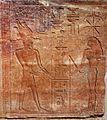Seshat facts for kids
Quick facts for kids Seshat |
|||||
|---|---|---|---|---|---|

Seshat, depicted in a leopard skin, inscribing the years of reign for the king on the palm-leaf rib hieroglyph for "year".
|
|||||
| Name in hieroglyphs |
|
||||
| Symbol | leopard skin, tablet, star, stylus | ||||
| Parents | Thoth and Maat (in some accounts) | ||||
Seshat was an important ancient Egyptian goddess. Her name means "female scribe," and she was known as the goddess of writing, wisdom, and knowledge. People believed she invented writing! She was also the goddess of many other things, like accounting, architecture, astronomy, mathematics, and surveying. She was like the ultimate record-keeper and planner for the pharaohs.
Contents
Who Was Seshat?
Seshat first appeared in ancient Egyptian history during the Second Dynasty. She helped King Khasekhemwy with a special ceremony called "stretching the cord." This ritual was very important for building temples and other big structures.
Seshat's Special Jobs
Seshat had many important jobs in ancient Egypt. She was seen as a divine measurer and scribe. This means she was believed to help the pharaoh with measuring and writing.
Helping with Buildings
Seshat helped the pharaohs with the "stretching the cord" ritual. This ceremony was used to plan the foundations of temples and other important buildings. It made sure the buildings were perfectly aligned and had the right measurements. She was also called the "mistress of builders." She helped plan how sacred places like temples would be built and made bigger. Her skills were also needed to measure the land again after the yearly floods. This helped re-establish the correct boundary lines between farms.
Recording History
Seshat was also in charge of writing down the speeches the pharaoh made when he was crowned. She also approved the lists of foreign captives and goods that were taken during military victories. During the New Kingdom, she recorded the years the king ruled and his special celebrations called jubilees. She would write these on the leaves of a special tree called the ished or persea tree. It was believed that she marked on her palm how long the pharaoh would live on Earth.
Keeper of Books
Another one of Seshat's titles was "Mistress of the House of Books." This meant her priests looked after the library where important knowledge scrolls and magic spells were kept. One prince from the Fourth Dynasty, Wepemnofret, was even called the Overseer of the Royal Scribes, Priest of Seshat. Her main sacred place was in Heliopolis.
Afterlife Helper
Seshat also played a role in the afterlife. Along with another goddess named Nephthys, she was believed to help put the body parts of the deceased back together.
Seshat and Thoth
Seshat was very close to Thoth, the god of writing and wisdom. They shared some similar jobs. Sometimes, Seshat was thought to be Thoth's sister, wife, or daughter. Seshat was believed to have invented writing, and Thoth then taught it to people.
What Seshat Looked Like
In ancient Egyptian art, Seshat was shown as a woman with a unique seven-pointed symbol on her head. We're not entirely sure what this symbol means. This symbol is why she had another name, Sefkhet-Abwy, which means "seven-horned."
She usually held a palm stem with notches on it. These notches were used to record the passage of time, especially to keep track of how long the pharaoh would live. She also held other tools, like knotted cords. These cords were used to measure land and buildings.
Seshat was often shown wearing a cheetah or leopard-hide. This was a symbol for priests who worked in funerals. If she wasn't wearing a real hide, her dress would have the spotted pattern of a big cat. People thought the spots on the animal hide looked like stars. This made the hide a symbol of eternity and connected her to the night sky.
Seshat's Emblem
The Seshat emblem is a hieroglyph that represents the goddess Seshat. It sits on top of her head in her pictures. The emblem was a long stem with a seven-petal flower on top, with two horns above it. An older version had seven petals and two sickle-shaped signs, with two falcon feathers on top.
Some experts believe the symbol might be a tool similar to a groma, which was used for surveying. The famous Palermo Stone from the 24th century BC shows Seshat's emblem many times. It appears on the stone in records for King Den. It was also used for God Seshu, who was seen as the male version of Seshat.
|
This hieroglyph roughly means: "YEAR: To create (a) Statue for Seshait, Statue for Mafdet."
Worship of Seshat
Seshat was mainly known for her official role as the recorder of building and writing projects. She didn't have her own temple or a special group of people who worshipped her in the same way as other gods.
Images for kids
-
Hatshepsut and Seshat, from the Red Chapel
-
Goddess Seshat, ca. 1919-1875 B.C.E., 52.129 Brooklyn Museum
-
Seshat carved on the back of the throne of the seated statue of Rameses II in the Amun temple at Luxor. It dates from around 1250 BCE.
-
Seshat, at the Karnak Temple Complex
See also
 In Spanish: Seshat para niños
In Spanish: Seshat para niños





